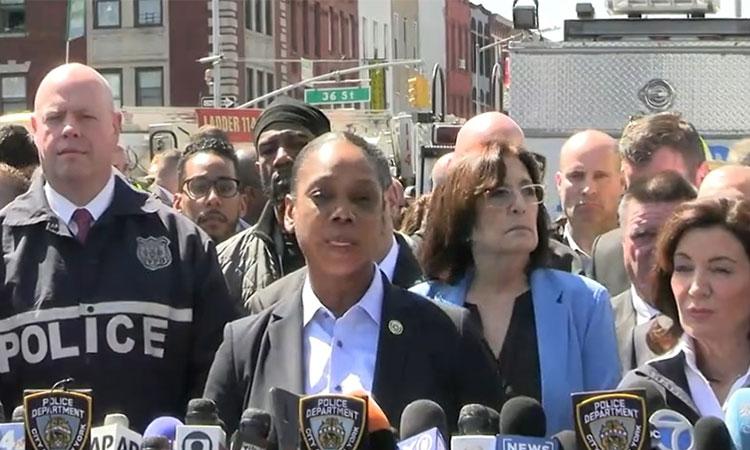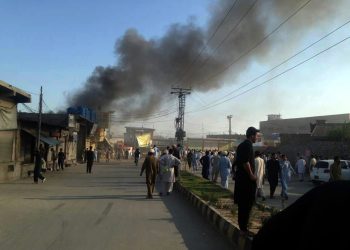New York: A manhunt was on for the mystery assailant behind the rush hour mass shooting in the city’s underground transit system that left 10 people with gunshot wounds and at least 13 others with other injuries.
Police Commissioner Keetchan Sewell said on Tuesday that terrorism was not being pursued for the moment as the motive, although nothing has been ruled out.
Officials from the city and the federal government investigating the morning shooting which seemed to be meticulously planned were puzzled by what triggered the attack.
A shooting or other mayhem with mass casualties is usually not considered by authorities as terrorism unless motivated by a definite political, religious or race agenda.
Although 33 shots had been fired, no one has died while five of those hit by bullets were reported to be in a critical condition.
A 9mm Glock gun mounted with an extended magazine that had jammed was found on the train, according to police.
That the gun jammed may have prevented greater mayhem.
The other 13 victims were injured by shrapnel or had been overcome by smoke or wounded during the scramble, according to the Fire Department which manages the ambulance service.
Videos and pictures posted by eyewitnesses showed victims lying on the blood-splattered train platform and train car and tended to by fellow passengers.
Some of the wounded passengers and others rushed to a train on the opposite side of the platform from the one that had been attacked and were taken to the next station for safety by the train workers.
Describing the attack, Sewell said that the shooter, whom she said was African American, put on a green vest and a gas mask as the train was pulling into a station before setting off a smoke canister, opening fire in the chaos that followed and disappearing into the station.
Mayor Eric Adams said that the surveillance cameras in the station in the city’s Brooklyn borough were apparently not working.
Police scrambled to get videos from nearby businesses.
Police said they also found two more magazines and a bag containing firecrackers, smoke bombs and a hatchet.
The key to a rented van found among the belongings abandoned by the suspect led police to look for a man from Philadelphia as a “person of interest” — meaning they did not have enough evidence to charge him right away but would need to question him.
The man, Frank R. James, was reported to have ranted on social media against the city’s Democratic Party mayor, an African American himself, who is taking strong steps to curb the rising tide of crimes, and about the problems of homeless people, whom the mayor has ordered removed from the trains and stations.
The city’s train transit system known as the subway, even though a substantial part of it runs overground on elevated tracks, has little security despite being considered a terrorist target.
Unlike in Delhi, passengers and their belongings are not checked at the entrances to the subway system and there are no metal detectors.
Anyone can just go through the turnstiles by paying the fare and enter the nearly 400-kilometre route system with 472 stations.
A 2009 plot to bomb the subway system by an Afghan-American failed when the man trained in an al-Qaeda camp in Pakistan was tipped off to surveillance by intelligence agencies and abandoned the attack.
A Bangladeshi man set off a pipebomb inside the Times Square subway station adjoining the city’s bus station hub injuring himself and three others in 2017.
According to the persecution he carried it out on behalf of the Islamic State terrorist organisation, but he said in court that he did not belong to it and was motivated by his anger at then-President Donald Trump.
While the mass shooting seems ominous, stabbings and other attacks happen almost daily making riding the subways a scary experience for the riders who make about 3 million trips daily, down from the pre-Covid level of over 5 million.
In March alone, 108 crimes were reported from the transit system, including buses.
Overall for the city, 9,872 crimes were reported, an increase of about 36 per cent over the same month last year.
While some attacks like last month’s hammer attack on a man or a woman having faeces put on her face, or a woman being pushed to her death in front of a train in January may sound dramatic, stabbings are almost regular occurrences that don’t even make the news on major newspapers.
Among recent cases: Last week a man was fatally stabbed in a train station and another suffered stab wounds in the Times Square station, while the week before a man was stabbed in the Wall Street station, and a woman train conductor was stabbed last month.
The overall crime increase in the city – as elsewhere in the country – is attributed to the anti-police campaign following the death of an African American man in Minnesota at the hands of the police and the changes made in New York state to allow most of those arrested for crimes to be let go without bail.
Although dropping the bail was presented by activists — many of them White — as a progressive measure for the benefit of African Americans and Latinos, the backlash came from those communities which bear the brunt of the crime wave, rather than the predominantly White neighbourhoods.
After protests by African Americans and Latinos, the bail reforms were recently scaled back.
Former Police Captain Adams was elected mayor on a tough law-and-order platform with wde support among those communities over the progressives who drew a substantial part of their support from liberal Whites.
(IANS)



















